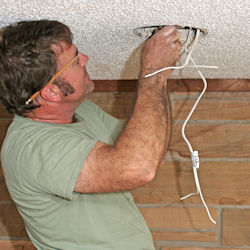Contact with Energized Sources
Major Hazards
The major hazards regarding contact with energized sources are electrical shock and burns.
Electrical shock occurs when the body becomes part of the electric circuit. This occurs when an individual comes in contact with both wires of an electrical circuit (one wire of an energized circuit and the ground, or a metallic part that has become energized by contact with an electrical conductor).
The severity and effects of an electrical shock depend on a number of factors, such as:
- the pathway through the body,
- the amount of current,
- the length of time of the exposure, and
- whether the skin is wet or dry.
Water is a great conductor of electricity, allowing current to flow more easily in wet conditions and through wet skin. On the next page is a table that discusses the effects of electrical shock.
Electrical burns can be arc burns, thermal contact burns, or a combination of burns. Electrical burns are among the most serious burns and require immediate medical attention. They occur when an electric current flows through tissue or bone, generating heat that causes tissue damage. The body cannot dissipate the heat generated by current flowing through the resistance of the tissue. Therefore, burns occur.
Description of Accident
The employee was attempting to correct an electrical problem involving two non-operational lamps.
He proceeded to the area where he thought the problem was. He had not shut off the power at the circuit breaker panel nor had he tested the wires to see if they were live. He was electrocuted when he grabbed the two live wires with his left hand and then fell from the ladder.
Inspection Results
As a result of its investigation, OSHA Issued citations alleging three serious violations. OSHA's construction standards include several requirements that, if they had been followed here, might have prevented this fatality.
What would you recommend?
Recommendations
- The employer should not allow work to be done on electrical circuits unless an effective lock-out/tagout program is implemented [29 CFR 1926.416(a)(1)].
- The employer should not allow work to be done on energized electrical circuits or circuits that are not positively de-energized or tagged out [29 CFR 1926.417(a) and. 417(c)].
Knowledge Check Choose the best answer for the question.
1-4. What are among the most serious burns requiring immediate medical attention?
You forgot to answer the question!


![[Alt-Title]](images/809_1_9_EnergizedCircuitA.png)
![[Alt-Title]](images/809_1_9_ExposedWiresA.png)
